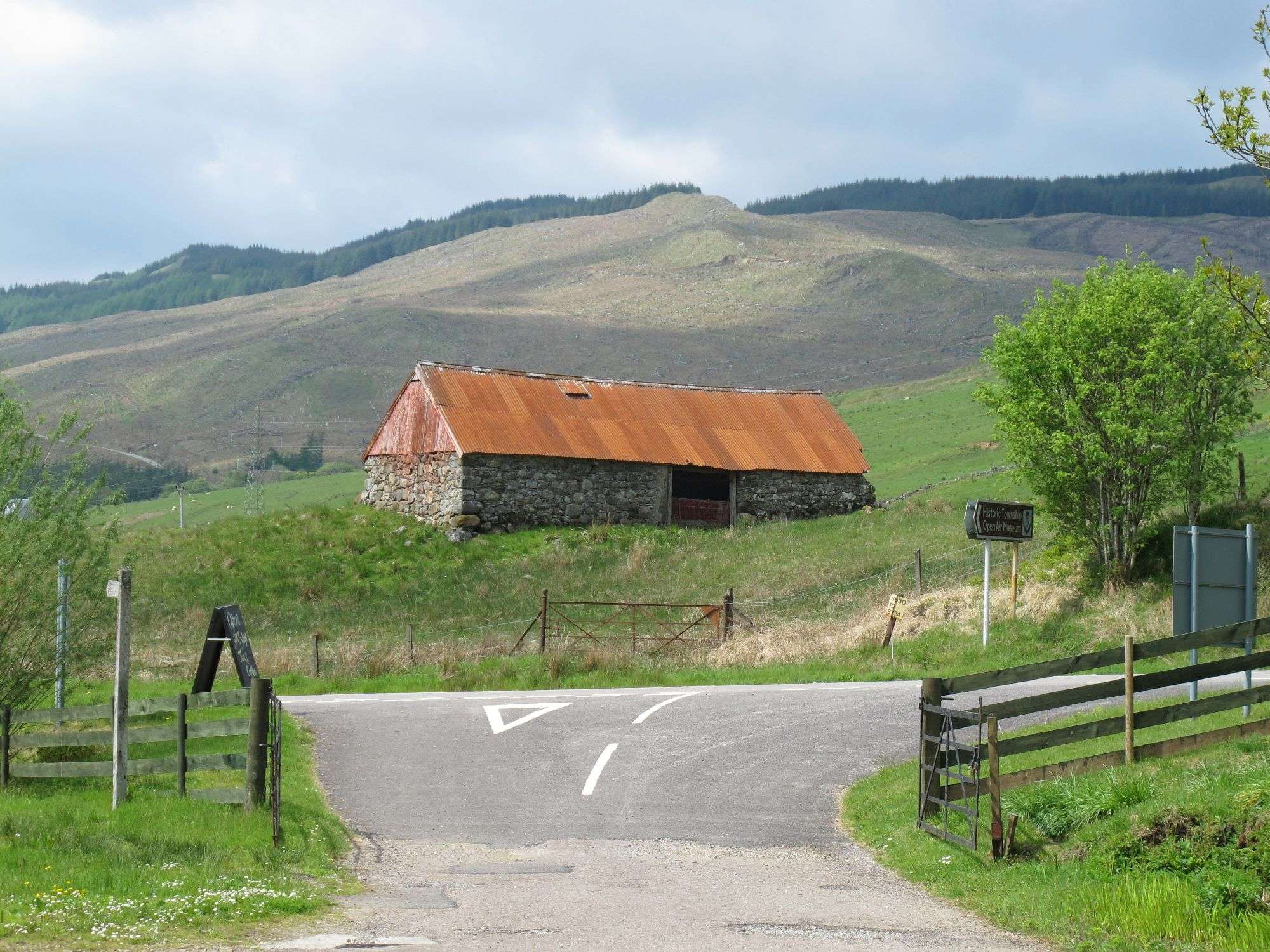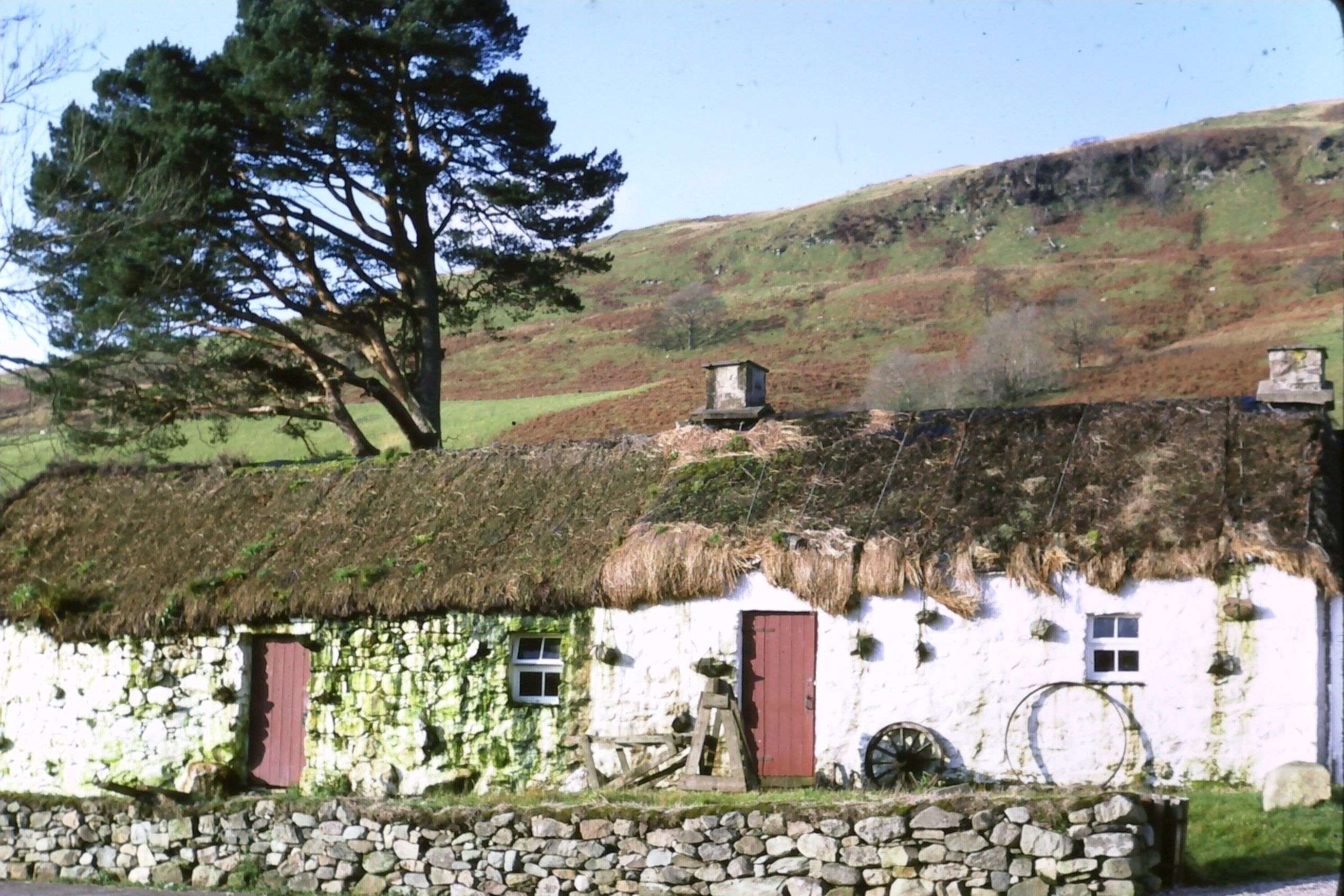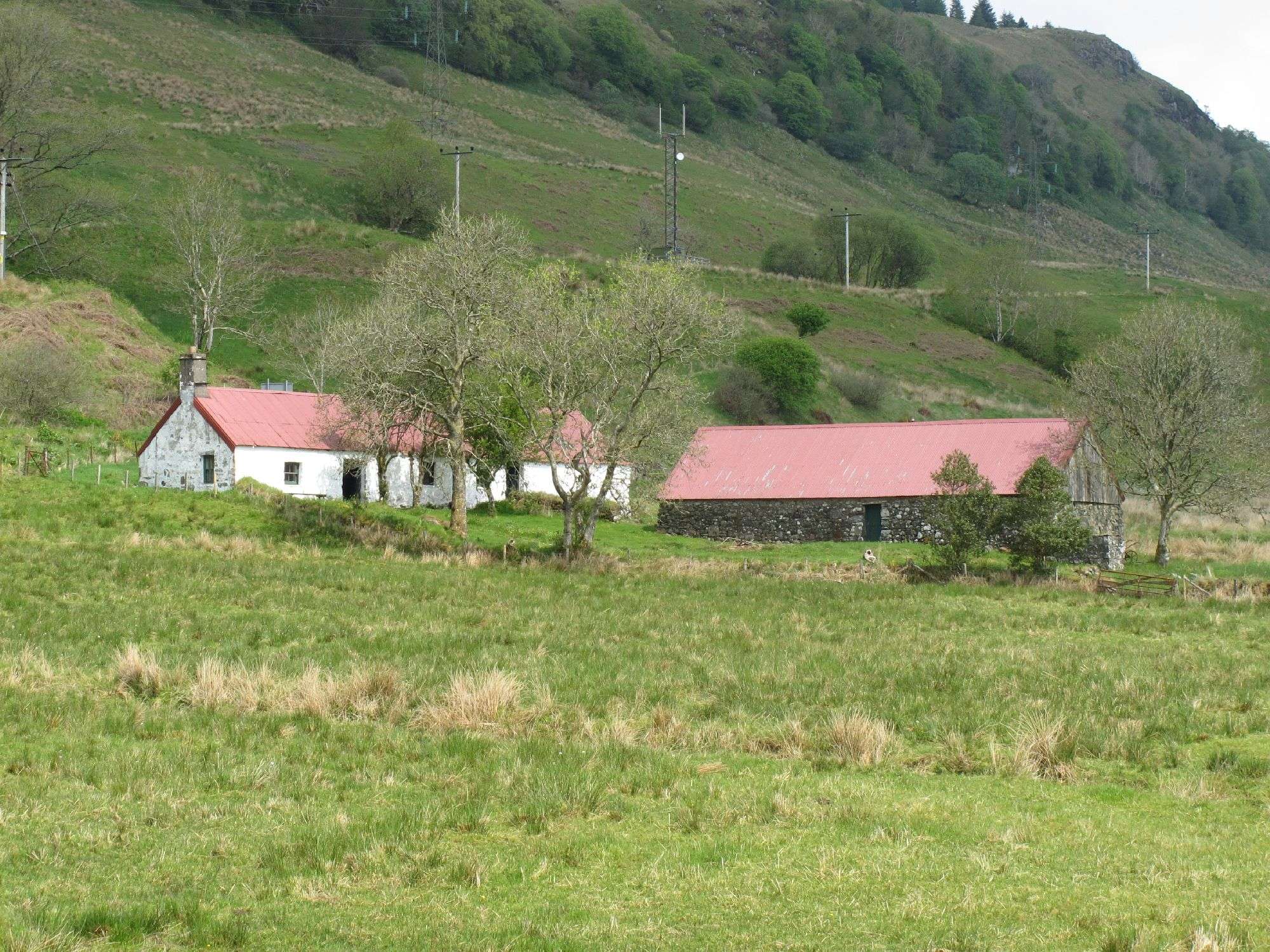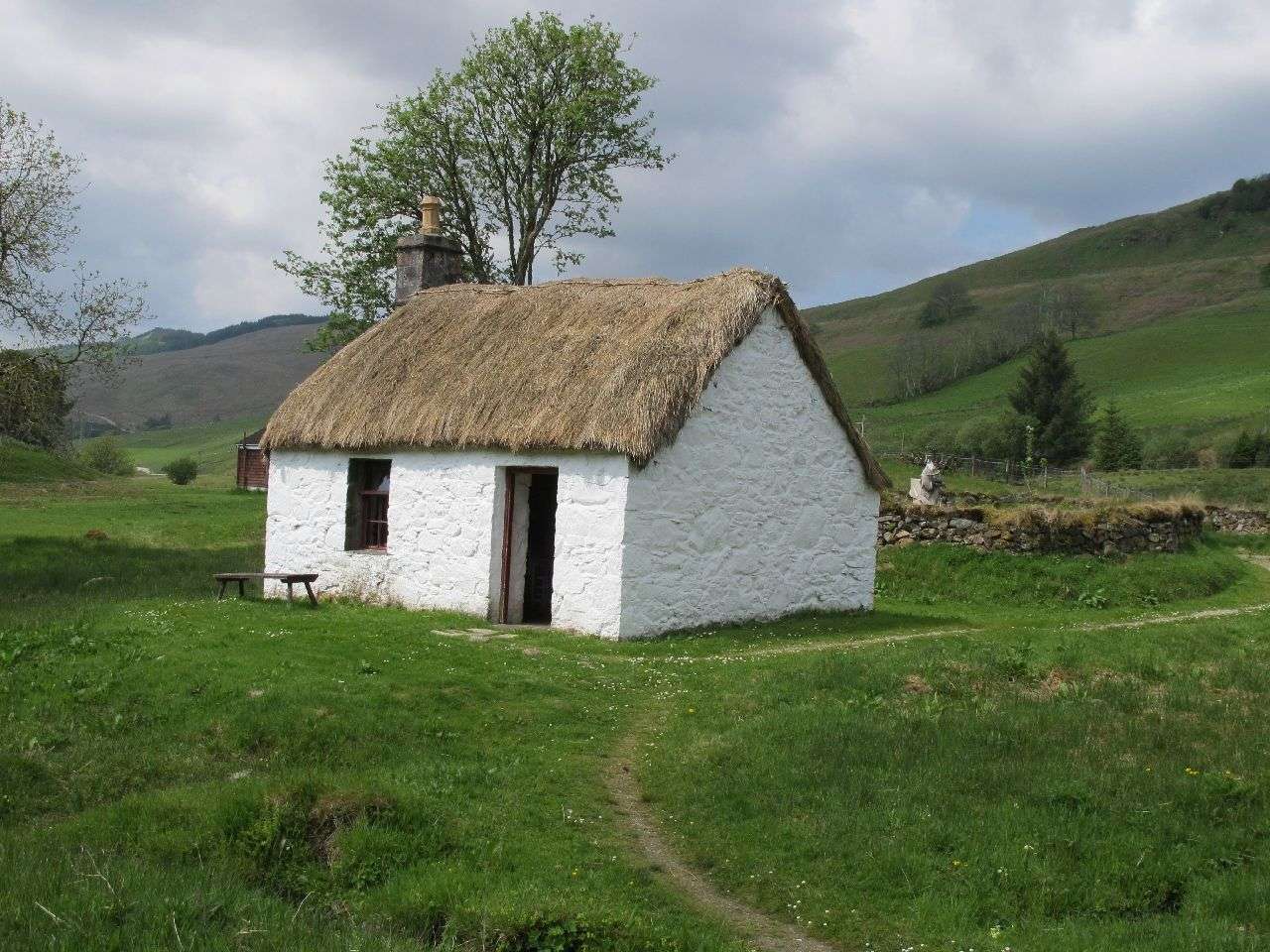During the Highland Clearances in the 18th and 19th centuries, when tenants were evicted across the Highlands and Islands, townships (clusters of agricultural smallholdings) steadily disappeared. Much of this activity, associated with the Scottish Agricultural Revolution of the 18th century, was based on agricultural improvement which involved the alteration of the usage of farmland to make it more profitable for the landowners. Most Scottish townships were affected by these changes between 1780 and 1860.
Some were converted into crofting townships, in which tenants had to combine farming with work in local industries for survival. Other townships were transformed into owner-occupied or single-tenant farms. In 1850 a handful of Highland townships remained, and by the early 20th century most had fallen into ruin, some ultimately being nearly effaced from the landscape. But one survived these massive upheavals: Auchindrain.
The blackthorn field

The name deriving from a Gaelic term meaning ‘the blackthorn field’ or ‘the field of the blackthorn tree’, Auchindrain is situated in Argyll and Bute, 10km south of Inveraray on the A83. Auchindrain first appeared in the historical record in the 16th century, but it may have been established earlier in the late mediaeval period. Having lost the township at some point, the Dukes of Argyll reacquired Auchindrain in 1776. In 1789 surveyor George Langlands drew up a plan for the dukes for the rebuilding and reorganisation of Auichindrain into crofts. Though the latter part of the scheme never came to pass (probably for economic reasons), in the ensuing decades rebuilding took place and the township adopted methods of improved agriculture, possibly with support and encouragement from the dukes, especially Duke George. By 1840 many of Auchindrain’s turf buildings had been reconstructed of stone.
During the rebuilding, there were some specifics for the arrangement of the structures according to the weather in the glen. Dwellings were resited so that they stood end-on to the prevailing winds of the area, so providing less wind resistance and fewer disturbances to their inhabitants. Threshing barns, on the contrary, were sited broadside to prevailing winds, so that drafts would rush through one open door and out the opposite open door, and so greatly assisting in the grain winnowing process.
Preservation of Auchindrain

Auchindrain made the transition from cattle to a sheep farm, and added a sheepfold on high ground west of the township. Though while keeping some cattle, the settlement was running as a full-fledged sheep farm by the 1870s. In accordance with the agricultural improvements, Auchindrain abandoned the awkward runrig method of planting and apportioned the arable land into small fields, two each being allocated to each individual tenant. While Queen Victoria was staying at Inveraray Castle in 1875, she visited Achindrain and Achnagoul (about 5km northeast of Auchindrain), and described them as “primitive villages”.
Auchindrain continued to operate far into the 20th century, becoming the final working Highland township until the last tenant Edward MacCallum retired in 1963. Preservation of Auchindrain began in 1964, and it opened as a museum in 1968. Today the site remains open to the public as the Auchindrain Township Open Air Museum, administered by the Auchindrain Trust. The grounds extend across 22 acres and feature more than 20 historic structures. Auchindrain is a working farm, with cattle, hens, sheep and horses all resident on the grounds. The entire site is Category A listed, is designated a Conservation Area, and its buildings are a Recognised Collection.

The Auchindrain Trust has overseen and operated the museum since 1964. The Scottish Government provides funding to the Trust via Historic Environment Scotland. Those interested in preserving Auchindrain can support the work of the Trust by becoming a Friend of Auchindrain. Donators who contribute £25 or more (£10 for seniors) per year are usually granted membership. Friends of Auchindrain become members of the Trust, can vote for trustees, and receive Auchindrain newsletters. The museum closed temporarily after several of its historic buildings were damaged in a Mid Argyll earthquake on 16 November 2021. Backed with funding from Museums Galleries Scotland, structural engineers and building conservation specialists worked on repairing the structures.
The museum reopened on 1 June 2022 during the ongoing repair work, restricting visitors to guided tours to keep them out of harm’s way. Visitors can obtain a guide-tablet or a guidebook at the Visitor Centre to assist in making one’s way round the site. A full circuit of the grounds takes 60-90 minutes. It’s recommended to dress for unpredictable weather changes, and to wear boots or heavy walking shoes to traverse the rough and sometimes muddy paths of the museum. Those with limited mobility will likely need assistance to reach some parts of the museum. Non-aggressive dogs on leads are welcome. The Visitor Centre, which houses a coffee shop and gift shop, is closed from November to March. During these months the museum offers a reduced entrance fee. Hours are daily, 10:30 to 4:30. Text by Eric Bryan.
Did you know?
Duke George
The 8th Duke of Argyll, Duke George was born in 1823 and lived at Inveraray Castle. In his teens he began to assist in managing the Argyll Estate, and became duke when his father died in 1847. Duke George contributed to the survival of Auchindrain by urging the tenants to adopt some of the methods of improved agriculture, and by allowing the settlement to continue as a joint-tenancy township. The Duke was a prolific writer, producing work on economy, geology, theology, politics, science and ornithology.
Inveraray Castle
Actually a country house, Inveraray Castle sits beside Loch Fyne in Argyll. There was a castle on the site in the 1400s, but the current building dates to the 18th century and is an early example of Gothic Revival architecture and has been the seat of the Dukes of Argyll since that time. Archibald Campbell, Earl of Ilay, later the 3rd Duke of Argyll, instigated improvements on the site of the original castle in 1743. Architects William Adam and Roger Morris based the idea for the new castle on a sketch done by Vanbrugh, the architect of Castle Howard and Blenheim Palace. In 1746 the foundation stone for the new building was laid. Adam and Morris died during the long construction of the castle, and Adam’s sons Janes and Robert completed the project 43 years after the laying of the foundation stone. The result was a then-modern, baroque, Gothic and Palladian style castle. The castle suffered an upper storey fire in 1877, which led to major restoration and additions to the structure. These, overseen by Anthony Salvin who was hired by the 8th Duke, include a third floor with dormers and a pitched roof, and conical roofs capping the four corner round towers. Circa 1890, Inveraray was the first home in Scotland to be fitted with electricity.
Main photo: Bell Pol’s House, Auchindrain by David Hawgood, CC BY-SA 2.0.


Loved the history! My husband (a Campbell) and I visited Inverarary 5 years ago. Too bad we did not know about Auchindrain then.